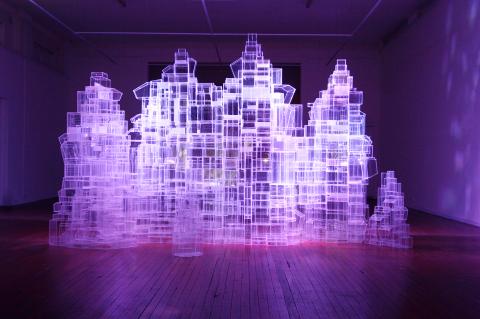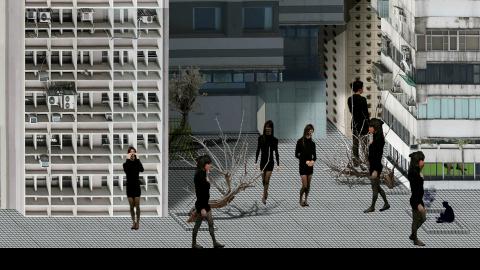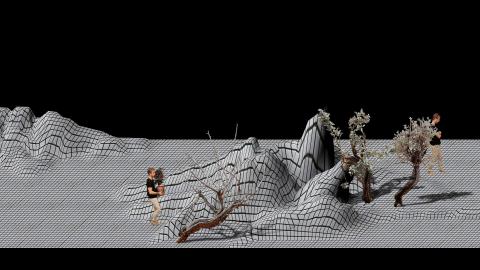Peter Nelson’s video Extensions of a No-Place (Wen Zhengming) contains traces of T. S. Eliot’s epic 1921 poem, The Waste Land: It is a barren and black-and-white landscape, where the most redeeming features are the dry stone of mountains, dotted with dead trees, juxtaposed with broken fragments of poetry and song.
It is disarming in such a way that you want to get inside this bleak, futuristic landscape (recalling the movie Tron Legacy in many ways) and stand beside the isolated characters.
But in this sense his exhibition, Extensions of a No-Place, which is part of the National Palace Museum’s New Waves Show in Tainan — comprising video, drawings and sculpture — achieves an aim of Chinese painting: to make the viewer want to swap places with the figures therein.

Photo courtesy of Peter Nelson
While it shares with The Waste Land alienation and fragmentation, high-intellectualism and broad allusion, Nelson takes artistic inspiration from Song Dynasty landscape paintings, such as Wen Zhengming’s (文徵明) Imitating Zhao Bosu’s Illustration of the Latter Red Cliff (仿趙伯驌后赤壁圖) and Qiu Ying’s (仇英) Spring Morning in the Han Palace (漢宮春曉).
Fractures
Nelson, who is Australian, is searching for something: perhaps the redemption that is a core part of The Waste Land; perhaps self-identity. Australia has arguably turned away from its mainly European roots to become part of the Asian continent it inhabits, rendering it the unintentional cultural heir of East and West.

Photo courtesy of Peter Nelson
Nelson’s search has taken him through Chinese landscapes, the 18th century British picturesque (Thomas Gainsborough and George Stubbs) and the 1970s utopian visions of the future. Physically, it has taken him to Paris, Chongqing, Beijing and Taipei, where he is doing a six-month residency at Treasure Hill Artists Village.
Wherever he goes, he is an outsider, alienated by language, culture and location, condemned to never really forming the bonds of community that allow for sustainable growth. This fracturing is reflected in the subject of his art, and also in the assorted media he uses, and within them the juxtaposition of cultural references and samples, forming a collage of recycled motifs. They combine to depict a pluralistic modern world of East and West.
Extensions of a No-Place (Wen Zhengming) takes the soft curves and colors of the mountains in Wen’s Imitating Zhao Bosu’s Illustration of the Latter Red Cliff, and replaces them with monotone mountains draped in patterns reminiscent of Taipei’s ubiquitous street tiles. The grid this creates, and which can be projected across five screens, brings it into line with the utopian architectural motif of squares. Taking landscape as coded self-portraiture further, Nelson places himself within it, appropriately, as the “lost man.”

Photo courtesy of Peter Nelson
Video games and chinese painting
Human instinct is to exert control — over ourselves, over others — in the quest for order, perfection or happiness. That we will create entire worlds to achieve this is exploited by the realms of fantasy and video games.
In Nelson’s second video, Extensions of a No-Place (Qiu Ying’s Spring Morning in the Han Palace), he draws parallels between the video game Starcraft and the Han Court, despite the 500-year-gap, through their use of isometric angles and oblique parallel perspective, which ensures the scenes have no vanishing points and objects are the same size no matter whether they appear in the foreground or background.
The effect, referred to as “moving perspective” in Chinese painting, is an endlessly extendable scene where no single point on the landscape has hierarchy over another (which is good for both ambulatory Chinese scrolls and large-scale sci-fi battles), and in terms of time, past and present are conflated, making the concept of time irrelevant.
In Nelson’s Qiu Ying the court buildings are replaced with a Sonyshop and Taipei apartments, and the female courtesans with versions of Nelson in drag, while the soundtrack plays in Mandarin and English lyrics from US rapper Eminem’s Without Me.
Mountains
It all started in the soaring, sublime mountains of China’s Zhangjiajie National Park, Hunan Province. The title of Mountain Drawing (The First Time I felt at Home), a 2.6m by 4.2m perspex sculpture, indicates that Nelson felt a connection.
But could this also be where it ends? In Qiu Ying, there is a devilish figure crouched down, creating smoke. This is in fact a silhouette of Nelson destroying First Time.
Shorn of The Waste Land’s spirituality, or any other redeeming feature, perhaps the title’s No-Place can only rely on Nelson’s Jade-like mountain sculptures — his final medium made from celadon ceramic through a 3D printer — to bear the burden of beauty and hope, where Jade represents purity, nobility and perfection.
Still, Nelson says he destroyed the sculpture in order to recycle it, which again recalls The Waste Land’s cycle of birth and death. In the poem’s very last stanza, many read hope in the Fisher King’s final words: “These fragments I have shored against my ruins.” Perhaps Nelson’s message is, with these fragments, that we can build our worlds.

That US assistance was a model for Taiwan’s spectacular development success was early recognized by policymakers and analysts. In a report to the US Congress for the fiscal year 1962, former President John F. Kennedy noted Taiwan’s “rapid economic growth,” was “producing a substantial net gain in living.” Kennedy had a stake in Taiwan’s achievements and the US’ official development assistance (ODA) in general: In September 1961, his entreaty to make the 1960s a “decade of development,” and an accompanying proposal for dedicated legislation to this end, had been formalized by congressional passage of the Foreign Assistance Act. Two

Despite the intense sunshine, we were hardly breaking a sweat as we cruised along the flat, dedicated bike lane, well protected from the heat by a canopy of trees. The electric assist on the bikes likely made a difference, too. Far removed from the bustle and noise of the Taichung traffic, we admired the serene rural scenery, making our way over rivers, alongside rice paddies and through pear orchards. Our route for the day covered two bike paths that connect in Fengyuan District (豐原) and are best done together. The Hou-Feng Bike Path (后豐鐵馬道) runs southward from Houli District (后里) while the

March 31 to April 6 On May 13, 1950, National Taiwan University Hospital otolaryngologist Su You-peng (蘇友鵬) was summoned to the director’s office. He thought someone had complained about him practicing the violin at night, but when he entered the room, he knew something was terribly wrong. He saw several burly men who appeared to be government secret agents, and three other resident doctors: internist Hsu Chiang (許強), dermatologist Hu Pao-chen (胡寶珍) and ophthalmologist Hu Hsin-lin (胡鑫麟). They were handcuffed, herded onto two jeeps and taken to the Secrecy Bureau (保密局) for questioning. Su was still in his doctor’s robes at

Mirror mirror on the wall, what’s the fairest Disney live-action remake of them all? Wait, mirror. Hold on a second. Maybe choosing from the likes of Alice in Wonderland (2010), Mulan (2020) and The Lion King (2019) isn’t such a good idea. Mirror, on second thought, what’s on Netflix? Even the most devoted fans would have to acknowledge that these have not been the most illustrious illustrations of Disney magic. At their best (Pete’s Dragon? Cinderella?) they breathe life into old classics that could use a little updating. At their worst, well, blue Will Smith. Given the rapacious rate of remakes in modern